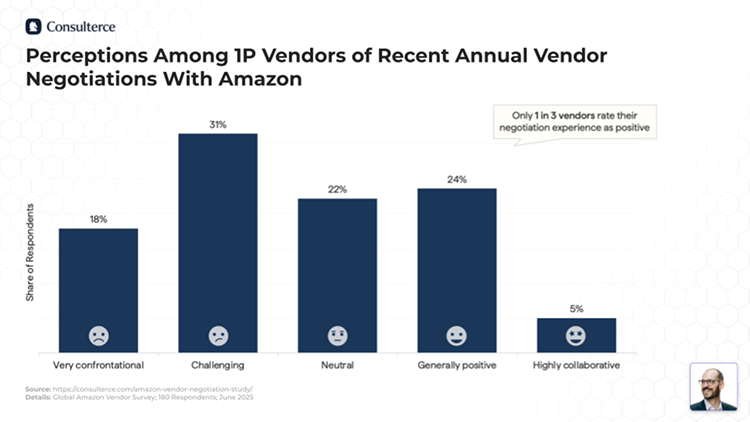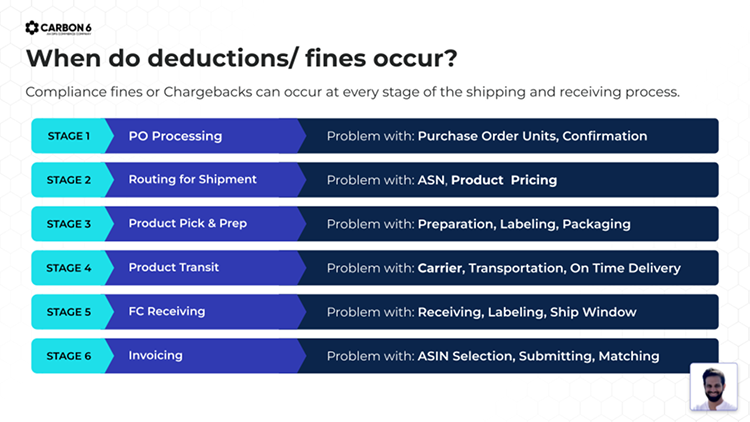Listen to This Article
Annual Vendor Negotiations (AVN) with Amazon are a high-stakes event where the outcome dictates profitability for the entire year. With rising tariffs and macroeconomic pressures, protecting your margins has never been more critical.
The landscape is difficult. Recent polls show nearly half of all brands find their Amazon vendor negotiation confrontational or challenging, and Amazon successfully increased its trade investments from vendors by 91 basis points in the last cycle. Success requires a proactive, data-driven strategy.

Based on our recent webinar with Amazon strategist Martin Heubel and Carbon6’s Makarand Bidikar, here is a clear playbook for turning negotiation risk into margin wins.
The Core Challenge: Amazon’s Moving Goalpost
Every Amazon AVN is driven by Amazon’s core metric: Net Pure Margin (Net PPM). As a former vendor manager, Martin Heubel explains, this target is a constantly moving goalpost.
“A brand can move heaven and earth to get to a 40% net PPM target, only to realize that in the years to come, the conversation is about a 45% target. This goalpost never stops, and it’s always just going to move northwards.”
~Martin Heubel, Founder, Consulterce
Vendor managers are tasked with improving margins annually. To protect your bottom line, you must build a narrative that quantifies your total value to Amazon—especially the contributions not captured in their Net PPM metric.
Strategies to Defend Your Margin
Success in your Amazon AVN hinges on countering investment demands with a data-backed narrative.
- Quantify “Hidden” Value: Have you improved your packaging with programs like Amazon Ships in Product Packaging (SIPP)? This creates direct fulfillment savings for Amazon that don’t appear in Net PPM. Quantify the dollar impact of these initiatives, along with contributions like reduced return rates, and present them as part of your value.
- Tie Allowances to Conditions: Instead of granting unconditional co-op fees, tie investments to clear deliverables. If you fund AVS, define a service-level agreement (SLA). Link operational allowances to specific outcomes, like chargeback waivers.
- Frame Cost Increases Strategically: When presenting necessary price increases, proactively show how you will help offset the margin impact. Detail a plan to shift ad spend toward more profitable items or use tools like Amazon Marketing Cloud and pair that with Amazon Subscribe and Save data to improve conversions.
The Secret Weapon: Turning Deductions into Leverage
Your most underutilized asset in any vendor negotiation strategy is often deduction data. Rising Amazon vendor chargebacks and shortages are not just a cash flow problem; they are a clear sign of operational friction.
“Statistically, almost 75% of different compliance issues which lead to chargebacks, have a direct correlation with your shortages or billings and other larger deduction types.”
~Makarand Bidikar, General Manager, 1P Recovery, Carbon6
As Makarand explains, a single error like incorrect labeling, can trigger a domino effect of deductions, from an Amazon ASN Accuracy chargeback to a massive Amazon Shortage Claim. Use this data to build a business case, not just a complaint. This is the foundation of effective Amazon Vendor Negotiations.

The Data-Driven Approach in Action
A Carbon6 client’s shortages spiked to 22% year-over-year. Instead of a standoff, they used data to partner with their vendor manager.
- Diagnosis: Data analysis traced 60% of their shortages to a carton labeling issue on just five ASINs.
- Strategy: The vendor presented this finding to their vendor manager, taking ownership and outlining a solution.
- The Ask: They framed the recovery of the shortage backlog as a one-time request needed to fuel a future growth plan that included increased investment in Amazon.
The result: a 70% payback on historic shortages and a stronger partnership. This data-driven approach transformed a confrontation into a collaboration.
Your 90-Day Amazon Pre Plan
Most vendors prepare for their AVN just 30 days out. A longer runway is a competitive advantage.
90 Days Out: Assemble & Analyze
- Form a cross-functional team: Involve sales, finance, marketing, and logistics.
- Conduct a full P&L analysis: Understand your total cost-to-serve, including deductions and advertising.
60 Days Out: Build Your Narrative
- Quantify your total value: Document all operational improvements and their financial impact.
- Analyze deduction root causes: Use Deduction Management Software to identify patterns in Amazon Vendor Chargebacks.
- Draft your negotiation deck: Build a clear story with data and specific asks using the Amazon AVN Checklist.
30 Days Out: Finalize & Align
- Model financial scenarios: Know the impact of potential concessions.
- Secure leadership buy-in: Align on your strategy, must-haves, and walk-away points.
- Prepare decoys: Include 2-3 negotiable asks you can concede to gain leverage on core objectives.
Take Control of Your Bottom Line
Thriving as an Amazon 1P vendor requires moving beyond reactive problem-solving. By preparing early, quantifying your complete value, and leveraging operational data, you can transform your Amazon AVN from a dreaded negotiation into a strategic partnership.
Turn Strategy into Action
The playbook above provides the framework for a successful negotiation. The resources below provide the tools and in-depth expertise to execute it.
Power Up Your 2025 AVN Prep
Don’t wait until Amazon sends the first proposal. The process of recovering deductions and building your case takes time.
- Act Immediately: Every day you wait, you risk losing the ability to dispute historical claims.
- Build Your Leverage: Uncover the hard data you need to challenge unfair fees and allowances.
- Negotiate from Strength: Turn operational insights into a powerful argument for better terms. Start Your Free, No-Risk Audit
Watch Our On-Demand Webinars
- Winning Your Next AVN: Want to dive deeper? Watch the full webinar that inspired this article for more examples and insights. Watch the Webinar Replay.
- Beyond Tariffs: Learn how successful brands are adapting to protect profits from rising costs across the board. Watch the Webinar Replay.







